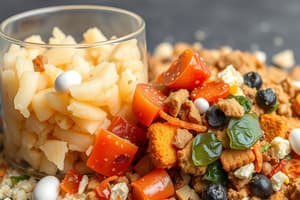Podcast
Questions and Answers
What is the definition of an impurity?
What is the definition of an impurity?
- A mixture of solute dissolved in solvent
- A substance that contains other elements or compounds (correct)
- A substance that dissolve in a solvent
- A substance made from one type of element or compound
In a solution with a high concentration of salt, what does this indicate?
In a solution with a high concentration of salt, what does this indicate?
- Low concentration of solvent
- Equal proportion of solute and solvent
- Absence of solute in solvent
- Large amount of solute in solvent (correct)
How does the color of orange juice change when a large glass of water is poured into it?
How does the color of orange juice change when a large glass of water is poured into it?
- The color becomes lighter (correct)
- The color turns green
- The color remains the same
- The color becomes darker
What does chromatography aim to accomplish?
What does chromatography aim to accomplish?
On what principle does chromatography work?
On what principle does chromatography work?
What is one of the applications of chromatography?
What is one of the applications of chromatography?
In a solution, what role does the solvent play?
In a solution, what role does the solvent play?
What is the main difference between a pure substance and an impurity?
What is the main difference between a pure substance and an impurity?
In a solution with a high concentration of salt, what does this suggest about the amount of solute present?
In a solution with a high concentration of salt, what does this suggest about the amount of solute present?
Why does the color of orange juice become lighter when water is added to it?
Why does the color of orange juice become lighter when water is added to it?
Which statement accurately describes the process of chromatography?
Which statement accurately describes the process of chromatography?
What does chromatography aim to accomplish?
What does chromatography aim to accomplish?
Which principle does chromatography primarily work on?
Which principle does chromatography primarily work on?
What is NOT an application of chromatography?
What is NOT an application of chromatography?
Flashcards
Impurity definition
Impurity definition
A substance containing other elements or compounds.
High salt concentration
High salt concentration
Large amount of salt (solute) in the liquid (solvent).
Orange juice color change
Orange juice color change
Adding water lightens the color.
Chromatography goal
Chromatography goal
Signup and view all the flashcards
Chromatography principle
Chromatography principle
Signup and view all the flashcards
Chromatography application
Chromatography application
Signup and view all the flashcards
Solvent role
Solvent role
Signup and view all the flashcards
Pure substance vs. impurity
Pure substance vs. impurity
Signup and view all the flashcards
High salt concentration (solute)
High salt concentration (solute)
Signup and view all the flashcards
Adding water to orange juice
Adding water to orange juice
Signup and view all the flashcards
Chromatography Process
Chromatography Process
Signup and view all the flashcards
Chromatography's Purpose
Chromatography's Purpose
Signup and view all the flashcards
Chromatography Principle (specific)
Chromatography Principle (specific)
Signup and view all the flashcards
Non-application of chromatography
Non-application of chromatography
Signup and view all the flashcards
Study Notes
- Pure substance is made from one type of element or compound.
- An impurity is a substance that contains other elements or compounds.
- Solute is a substance that dissolves in a solvent, while a solvent is the liquid in which the solute dissolves, resulting in a solution.
- A high concentration of salt in a solution indicates a large amount of solute in the solvent.
- Mixing a glass of orange juice with a glass of water will result in the orange juice becoming lighter due to the higher amount of water.
- Chromatography is a method to check the number of solutes in a solvent and involves separating substances dissolved in a liquid by allowing the liquid to flow through a chromatogram.
- Chromatography works based on the principles of compound concentration and separating compounds in mixtures.
- Applications of chromatography include drug testing, forensic analysis, and food testing.
Studying That Suits You
Use AI to generate personalized quizzes and flashcards to suit your learning preferences.




